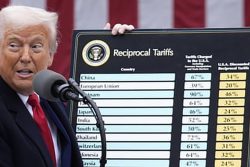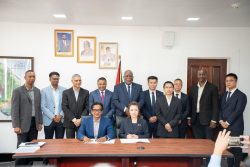Introduction
Last week’s column covered the strategic role of maintenance in GuySuCo’s efforts to modernize the sugar industry. This week I shall discuss respectively, the strategic roles of privatization and mechanization. Last week, I adverted to the fact that, in giving Booker Tate a management contract to run GuySuCo, this symbolized the pivotal role the government expected private stakeholders to play in the future of sugar.
Role of privatization
Booker Tate initiated the Skeldon Sugar Factory Modernization Project (SSMP) at GuySuCo. In its 1998 Strategy Review, it formulated a policy to develop cadres of private independent cane farmers to supply cane to the Skeldon factory. This targeted the Berbice-Corentyne, even though traditionally most of the industry’s private cane farming has taken place in Wales.
GuySuCo’s Strategy Review also envisaged leasing lands to private independent farmers who would develop them as farm managers and operators to produce cane on contract for GuySuCo’s factories.
 The strategy showed that the intention was to involve the independent cane farmers not only in supplying cane, but also in broader sugar-related operations. Indeed it forecast a participatory role for them in the design of the Skeldon expansion project. From all indications this included their involvement in the critical areas of water control and management (including drainage and irrigation) on the sugar estates.
The strategy showed that the intention was to involve the independent cane farmers not only in supplying cane, but also in broader sugar-related operations. Indeed it forecast a participatory role for them in the design of the Skeldon expansion project. From all indications this included their involvement in the critical areas of water control and management (including drainage and irrigation) on the sugar estates.
It goes without saying that GuySuCo expected the private independent sugar cane farmers to deliver cane to its factories at a cheaper cost than GuySuCo could, as otherwise this would not make commercial sense. Commercially, however, this outcome depends largely on the contract price at which privately produced cane is supplied to the estates.
Contract price setting for private cane deliveries to sugar factories is both a complicated and complex matter, which I will not address in this column as I have previously done so.
Cane farmers contract price
Readers may recall that, when I did so before, I dwelt on three crucial considerations.
These were 1) Since farmers’ cane is not processed separately from the estate’s cane, how is the quality of that cane to be established? (Note this would have a large bearing on the price received, and the time of payment). 2) When should private farmers be paid – at the time the cane is accepted at the factory or after the sugar is produced and eventually sold? (Note this could be some time later!) 3) If, however, the situation is one where the cane contract payment is settled after the sugar is sold, which party to the transaction (buyer or seller) should bear the cost of this deferred payment? (Note ‘time is money.’)
Over the past decade or so, the key performance data for the present private cane farming sector reveals that 1) between 6-8 per cent of GuySuCo’s cane supply has come from private cane farmers; 2) the geographic distribution of private cane farming across the industry varies considerably, with Wales being by far the most important community; and 3) the technical performance of the cane farmers also varies considerably.
Observation
Expanding the role of private stakeholders is critical to the future of the sugar industry. However, GuySuCo’s efforts aimed at producing “governance benefits” for itself has faltered badly. Despite this it remains the case that GuySuCo cannot fulfil its mission if it does not enhance the role of non-state actors and supporters in its operations, beginning with its Board of Directors.
This matter will be taken up when I consider reform of the sugar industry, as my final topic in this series on sugar, beginning next week.
Role of mechanization
Two separate, but related factors have underlain GuySuCo’s drive to mechanize its operations. On the one hand the corporation does not want to continue fuelling its sugar production using cheap labour, for two reasons. First, over time it has become increasingly difficult to recruit cheap labour, as alternate job and livelihood opportunities have expanded for GuySuCo’s labour supply. Second, as any economist would tell you, cheap labour could be very expensive to a firm!
An enterprise measures what it pays in wages and benefits, against the output or productivity it is getting from those it employs. This is commercially attractive only if the wages and benefits paid cost less than the value which the workers produce. Oftentimes cheap labour has low productivity (largely because of its low-skill level). Paying a ‘cheap or low wage’ can be costly if the labour, because of its low productivity, adds less to the revenue earned by the enterprise than its cost.
The other factor behind GuySuCo’s drive, however, is that it expects introducing machines into its production process would raise output and productivity because of the productivity of the machines, not its labour. Of course the more productive is its labour, the better overall for the enterprise.
Limits
However, the natural agricultural environment on GuySuCo’s estates: land quality, layout, and physical structure of the soil, pose severe limits to the extent of possible mechanization.
The bias therefore, has been in favour of pushing the mechanization of loading operations, and proceeding cautiously with the mechanization of cutting and stacking canes. It should be noted though that efforts are afoot to prepare the expansion lands at Skeldon for mechanized cutting.
Readers would reasonably expect a continuous evaluation of the costs and benefits of labour versus machine operations in both cane and sugar production and distribution. Little information, however, has been made public by GuySuCo since its 2009 Annual Report.
Its reporting on these evaluations has been scant, which does not help either industry stakeholders or the wider Guyanese public to form independent judgements as to whether further mechanization is commercially feasible.









